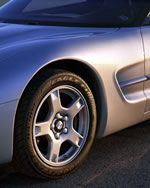 |
Goodyear's
run flat tire |
Women
drivers are still at greater risk than male drivers when stranded at roadside.
That's reason enough for them to delight in the swelling interest in run-flat
tires. Not that these tires actually run flat; more correctly they simply do not
go flat even though they are as empty of air as the moon.
Airless,
the tire supports itself — and the car — on stiffened panels in the sidewalls.
With no noticeable alternation in performance, the airless tire can be run at
speeds up to 55 mph for 50 to 150 miles depending on the vehicle. Plenty of leeway
to get to the safety of a friendly repair shop.
Goodyear,
pioneer of the run-flat tire, developed it for such cars as the Corvette and the
Plymouth Prowler. These specialty two-seaters have humongous tires and no space
to tote a spare. Run-flats were born of necessity. This
year the run-flat Goodyear EMT (Extended Mobility Tire) is offered as an option
on the Mini Cooper,
in comparison to the Corvette and Prowler, mass-market automobiles. BMW, makers
of the British-built Mini, is clearly a believer in this tire technology. The
company also offers run-flats as an option on their 3 series cars and on an upcoming
540i. BMW may well be the first manufacturer to go all run-flat if and when a
spare-less day dawns.
That
could be a near thing if public interest has weight. A survey by J.D. Powers
showed that seven of eight consumers put run-flats near the top of the list of desired
traits for their next car. Because the driver cannot tell by look or feel if
a run-flat tire is "flat" the tire makers require that run-flat users
have a pressure monitoring system to warn them, either by in-cockpit sight or
sound, of low pressure conditions. And anyway Federal law requires that by 2003
all new cars have such a device.
The
self-supporting system of run-flat tires is the one currently in greatest use
by other tire makers as well as Goodyear. The Dunlop
SP Sport, Goodrich
Comp T/A and Michelin
ZP (for "zero pressure) are examples. Another
system called PAX, under development by Michelin in conjunction with other tire
makers, has some advantages over the self-supporting tire. The support system
for the PAX is built into the wheel itself. It is thus considerably more costly
at this stage but it permits the modern ultra-low profile tire with larger wheel
diameter popular with modern designers. It also has less rolling resistance and
is thus "greener" requiring less fuel to keep it going. And
coming, too, are run-flats suitable for the weight and tough duty of off-road
trucks and SUVs.
Is
the spare tire going the way of the running board? Quite possibly. After all will
anyone really miss changing a flat on a dark, wet, narrow road? (By rule, that's
where 95 percent of flats occur).
As
public awareness increases, as more carmakers offer run-flats as original equipment,
as more run-flats in varying sizes enter the market and as pressure monitoring
systems are retrofitted to older cars watch for more run-flats on the road. And
plan what you can do with that extra space in the trunk. |